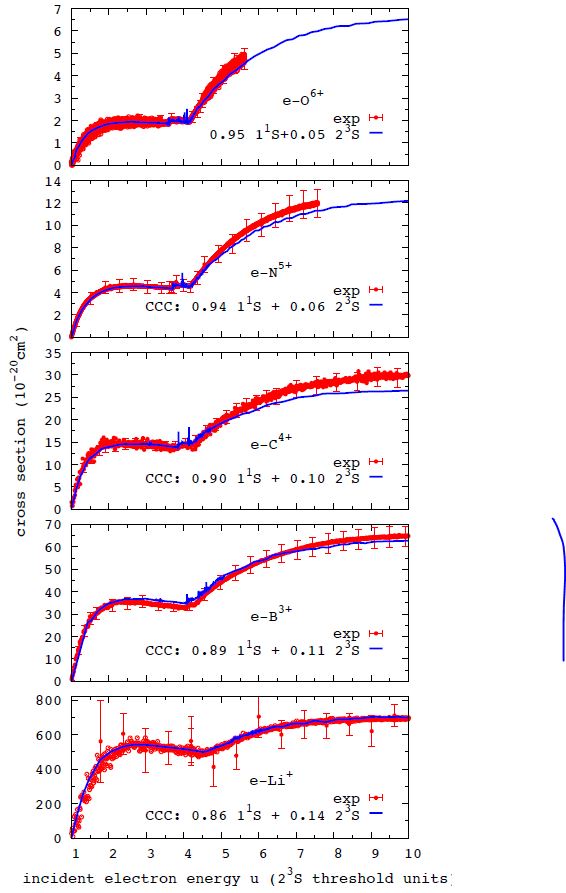Atomic Collision Theory
The goal is to develop the required theory and to calculate collision processes on the atomic scale of interest to science and industry. Such collisions go on all around us and inside us. All light that we see is either due to, or is influenced by, collisions on the atomic scale. All chemical reactions are examples of atomic collisions. Consequently, there is no shortage of applications in the field. These include the physics of lasers, upper atmosphere, astronomy, medical imaging and therapy, nanolithography, lighting and fusion energy. There is also no limit to the complexity of the problems of interest, particularly those involving molecular targets.
Area of science
Geosciences, Physical Sciences
Systems used
Magnus, Zeus, Topaz and Managed Storage
Applications used
CCC: in-house fortran codeThe Challenge
Our calculations will:
Provide cross sections for electron scattering on tin and its ions for the Advanced Research Center for Nanolithography (https://arcnl.nl/) in support of the generation of 13.5 nm light for making the next generation of computer processors.
Be applied to the emerging area of cancer hadron therapy (proton and higher charged ions destroying cancerous cells) via the determination of the stopping power of ions colliding with water molecules.
Address charge-exchange processes due to ion scattering on atoms and molecules in high energy events in the universe observed by a multitude of space-based X-ray telescopes.
Provide benchmark data to the International Atomic Energy Agency in support of the fusion energy development at ITER, the biggest scientific project on the planet.
Determine the galactic temperatures by providing benchmark results for electron scattering on highly charged Fe ions.
Provide cross sections for antihydrogen formation to support the experimental implementation at CERN.
The Solution
Run existing implementations of the Convergent Close-Coupling (CCC) method, and extend to increase functionality
The Outcome
Our work is critically dependent on Pawsey as our work is 95% computational we have been users of leading supercomputer technologies for our entire careers of nearly four decades.
List of Publications
Fully differential cross sections for single ionization of helium by energetic protons
IB Abdurakhmanov, AS Kadyrov, SU Alladustov, I Bray, K Bartschat
Physical Review A 100 (6), 062708
Cross sections for electron scattering from atomic lead
MP van Eck, DV Fursa, I Bray, O Zatsarinny, K Bartschat
Journal of Physics B: Atomic, Molecular and Optical Physics 53 (1), 015204
Calculations of positron scattering on the hydrogen molecular ion
NA Mori, R Utamuratov, LH Scarlett, DV Fursa, AS Kadyrov, I Bray, …
Journal of Physics B: Atomic, Molecular and Optical Physics 53 (1), 015203
Laser-driven production of the antihydrogen molecular ion
MC Zammit, M Charlton, S Jonsell, J Colgan, JS Savage, DV Fursa, …
Physical Review A 100 (4), 042709
The stopping power of hydrogen for protons and antiprotons
JJ Bailey, IB Abdurakhmanov, AS Kadyrov, I Bray
State-of-the-art Reviews On Energetic Ion-atom And Ion-molecule Collisions 2 …
Convergent close-coupling calculations of positron scattering on
R Utamuratov, DV Fursa, AS Kadyrov, I Bray
Physical Review A 100 (4), 042703
Atomic data for astrophysics: Needs and challenges
G Nave, P Barklem, MT Belmonte, N Brickhouse, P Butler, F Cashman, …
BAAS 51 (7), 1
Electron-Impact Dissociation of Vibrationally-Excited Molecular Hydrogen into Neutral Fragments
LH Scarlett, JS Savage, DV Fursa, MC Zammit, I Bray
Atoms 7 (3), 75
Roadmap on photonic, electronic and atomic collision physics: II. Electron and antimatter interactions
S Schippers, E Sokell, F Aumayr, H Sadeghpour, K Ueda, I Bray, …
Journal of Physics B: Atomic, Molecular and Optical Physics 52 (17), 171002
Electron capture, excitation and ionization in He2+–H and H+–He+ collisions
J Faulkner, IB Abdurakhmanov, SU Alladustov, AS Kadyrov, I Bray
Plasma Physics and Controlled Fusion 61 (9), 095005
Spin asymmetry in electron-impact ionization
I Bray, DV Fursa, AS Kadyrov, A Müller, A Borovik Jr, S Schippers
Physical Review A 100 (1), 012707
Effect of cascade transitions on the polarization of light emitted after electron-impact excitation of Zn by spin-polarized electrons
K Bartschat, O Zatsarinny, CJ Bostock, DV Fursa, I Bray, …
Physical Review A 100 (1), 012702
Configuration space method to calculate rearrangement matrix elements
R Utamuratov, DV Fursa, AS Kadyrov, I Bray
Computer Physics Communications 239, 64-71
Wave-packet continuum-discretization approach to proton collisions with helium
SU Alladustov, IB Abdurakhmanov, AS Kadyrov, I Bray, K Bartschat
Physical Review A 99 (5), 052706
Recommended electron-impact excitation and ionization cross sections for Be I
Dipti, T Das, K Bartschat, I Bray, DV Fursa, O Zatsarinny, C Ballance, …
Atomic Data and Nuclear Data Tables 127, 1-21
Balmer emission induced by proton impact on atomic hydrogen
IB Abdurakhmanov, O Erkilic, AS Kadyrov, I Bray, SK Avazbaev, …
Journal of Physics B: Atomic, Molecular and Optical Physics 52 (10), 105701
Positron-impact electronic excitations and mass stopping power of
R Utamuratov, DV Fursa, N Mori, AS Kadyrov, I Bray, MC Zammit
Physical Review A 99 (4), 042705
Proton-beam stopping in hydrogen
JJ Bailey, IB Abdurakhmanov, AS Kadyrov, I Bray, AM Mukhamedzhanov
Physical Review A 99 (4), 042701
Vibrational excitation of the state via electron-impact excitation and radiative cascade
LH Scarlett, JK Tapley, JS Savage, DV Fursa, MC Zammit, I Bray
Plasma Sources Science and Technology 28 (2), 025004
State-of-the-art Reviews on Energetic Ion-atom and Ion-molecule Collisions
D Belkić, I Bray, A Kadyrov
World Scientific Publishing Company Pte. Limited
Development of convergent close-coupling approach to hadron interactions with matter
AS Kadyrov, IB Abdurakhmanov, SU Alladustov, JJ Bailey, I Bray
Journal of Physics Conference Series 1154 (1)






